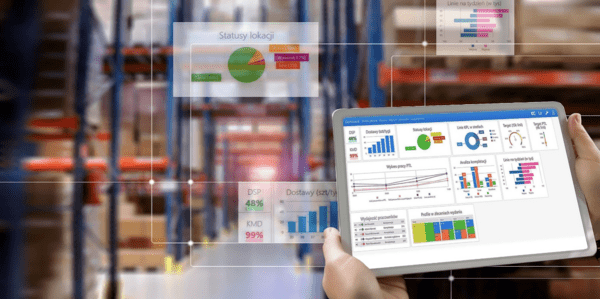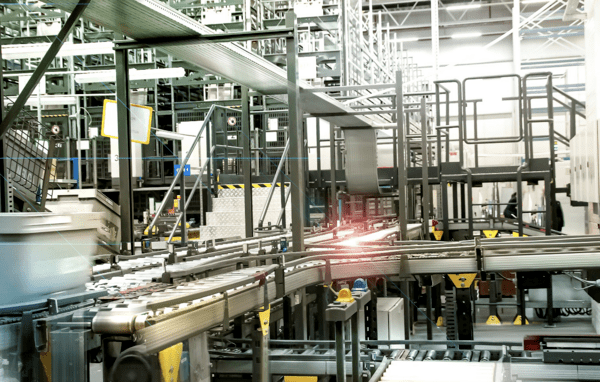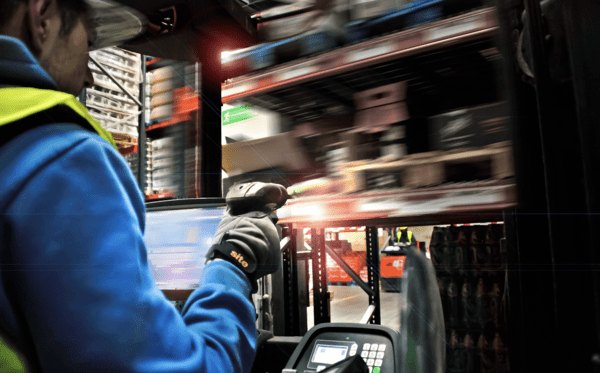
WMS – what is it? How to choose the right one? How much does it cost?
WMS systems have recently become quite popular topic in the logistics industry. With the growing popularity of these solutions, market players want to learn more about them. However, they can still be consider a niche tool, so trust in them may be somewhat scarce. That’s the whole reason why we’ve written this piece: to discuss all the most important WMS-related issues and answer your questions. Read on for more
What is a WMS?
WMS stands for ‘Warehouse Management System’ and refers to an integrated warehouse management software that provides support for the management warehouse processes (from receipt to shipping) and allows real-time tracking, control and analysis. The system combines all workstations and machines into one centrally managed network..
Once implemented, a WMS maps a virtual warehouse onto its physical counterpart. The process should be carried out in such a way as to address the following issues:
- the warehouse’s physical and functional layout design and the structure of intermodal transports,
- warehouse-specific material flow processes,
- user assignment to individual warehouse operations/processes and appropriate authorisations,
- distribution structures (shipment organisation),
- fixed product data,
- types of handling units.
A WMS is a central hub amassing and processing real-time data used by managers to optimise their decisions regarding warehousing operations. This provides the warehouse management with a broad overview of the overall workload and task progress to enable supervision of workflows and early response in the event of any disruptions to or irregularities in the process.
Management decisions (e.g. concerning goods receipt, release of orders for picking, etc.) are automatically divided into sub-task by the WMS. This tasks are transmitted by radio to handheld scanner or forklift scanner operated by dedicated employees, or directly to the warehouse automation equipment. The employees receive the tasks on their devices are guided trough the processes step by step. The employee can either close the task in the system or indicate any problems that may have occurred. The supervisor can then react accordingly.
In a nutshell: with a broad real-time overview of warehouse processes, it is possible to respond immediately to any problems as they arise in order to ensure continuity of operations.
Also, since all the information flowing through the system is recorded, you can refer back to your historical data to check up on any issues that may have occurred during the workday. Trace the progress of any task, or monitor individual employee performance, in order to provide better-tailored feedback. The historical data stored in WMS are used to compile all kinds of reports for the management to streamline on-going operations and plan for long-term improvements across the logistics chain.
How is a WMS structured?
A WMS can take one of two forms:
- Autonomous – it is a standalone tool, completely independent of other systems, but has the capability to integrate with other systems used in the warehouse, such as e-commerce and courier platforms.
- Modular –it is an integral part of an ERP (Enterprise Resources Planning) system, i.e. software for managing all the company’s resources. Such modules generally have limited functionality and are only suitable for managing a small warehouse with a simple logistics structure.

What can you do with a WMS?
A WMS achieves superior warehouse efficiency in terms of productivity and quality of work. The system will track, coordinate, control, analyse and optimise the processes, activities and operations within the warehouse. What does this mean in practice? For example, warehouse stock is tracked based on the information about the exact location of individual warehouse units. Warehouse process statuses are monitored from receipt to release, and deliveries are verified for compliance with the waybills and customer orders. The system also guides employees in their work and allocate orders to be processed by workhouse automation.
In automated warehouses, a WMS is responsible for generating and allocating tasks to the warehouse automation equipment and their execution through the MFC (Material Flow Control) layer. The tasks include managing the flow of goods on the conveyors, automatic storage, sorting, movement of autonomous AGVs (automated guided vehicles), automatic picking, packing, palletising/depalletising, etc.

Properly developed and integrated with a production system, a WMS can effectively support the management of material flow processes in a production facility, considerably reducing order picking times. It can, for example, supply the required production materials to production buffers, control material movement between these buffers, manage the receipt of finished products from the production line, as well as consolidate and direct them to the finished goods warehouse.
An extremely important feature of WMS systems is that they can be fully integrated with other management systems in the enterprise, such as:
- ERP systems that manage company resources;
- MES (Manufacturing Execution System) systems that support production;
- E-commerce platforms that support online sales;
- TMS (Transport Management System) systems for transport management;
- Courier platforms/services;
- MFC (Material Flow Control) warehouse automation control systems – this refers to equipment such as pallet and carton conveyors, sorters, automatic and semi-automatic warehouses, automatic picking machines, autonomous AGVs, etc.
These are, of course, only the simplest examples – the full range of potential is much wider. The scope of a software warehouse should be based on the specific needs of the client. Therefore, it should be flexible enough to support the specific needs of the company and its logistics. Each WMS is unique in its own way
Where will a WMS deliver value for money?
WMS systems will be suitable for use virtually anywhere there is storage and movement of goods, raw materials or finished products – warehouses, logistics centers, production plants, transshipment points, large retail outlets and many other similar facilities.
Contrary to persistent misconceptions, WMS systems are not only useful for large companies. These types of systems can be implemented successfully in virtually any warehouse, including smaller ones. A WMS is fully scalable and individually adaptable to the logistics needs of a specific company in any industry..
Obviously, the smaller the company, the smaller implementation cost. It is therefore also an interesting solution for small and medium-sized companies that handle less complex processes and have a facility with a small storage space.
Advantages of WMS
High-quality storage systems are characterized by a number of advantages. Here are some of the most important ones:
- Scalability – a well-designed WMS can be easily adapted to any warehouse, regardless of its size;
- Open structure – warehouse software can be extended and adapted to the evolving needs of the company;
- Flexibility – a WMS can be adapted to the specific needs of the company’s logistics;
- Versatility – WMS software works well in warehouses of all sizes and complexities, in a variety of industries, in both manual and automated warehouses;
- Open to cooperation with the IT environment – a mature warehouse programme can be easily integrated with other IT tools of the company (e.g. ERP system, production management system).
logifact®WMS has all the above advantages and more, as we assure its continuous development and after-sales support. Therefore, by choosing our warehouse programme, you will not only gain a reliable tool tailored to the needs of your company, but also have ready access to assistance in its operation and development, while being able to adapt to the changing market needs.

Why choose a professional warehouse management system?
There are a number of benefits from implementing a WMS, including:
Easier and smoother warehouse management
The implementation of a WMS ensures constant, real-time supervision of warehouse processes and the work of warehouse employees. All the information relevant to warehouse management is available online in a clear and easily legible form. This means a quick and correct assessment of the warehouse situation and, consequently, rational decision-making on the part of the management.
A warehouse information system enables a wide range of self-configured parameters to streamline the operation of the system, allowing warehouse process management to be tailored to the needs of a particular facility.
It effectively supports the generation of work tasks and their automatic allocation to the relevant warehouse employees. These are clear, unambiguous instructions to guide the warehouse employees according to precise procedures.
Stocktaking processes are also significantly improved. For example, a WMS supports the automatic creation of stocktaking lists for locations selected according to the agreed algorithms, allows the stocktaking process to be carried out without stopping the warehouse work, and enables ad-hoc stocktaking – without creating stocktaking lists in locations selected by the warehouse worker, etc.
Streamlining logistics processes
The history of operations available in the system allows each logistics process to be traced in detail. Based on this data, it is easy to identify processes that need streamlining. The resulting information will allow you to assess which elements of a given process require intervention.
Lower warehouse running costs
A warehouse management system considerably reduces the operating and maintenance costs of a warehouse. A WMS means, above all, much better organisation of warehouse operations and optimally managed logistics processes, resulting in increased productivity. The warehouse can then reduce the size of staff and the amount of technical equipment, or – alternatively – boost the throughput for better productivity with the same resources (by increasing the volume of orders).
Implementing a WMS can also result in less obvious savings. For example, by reducing the number of errors in shipments, the warehouse will see less expense in handling complaints and returns. It is equally important to ensure the timeliness of orders, without which the business runs a high risk of penalties. What is more, a warehouse management system shortens the time it takes to train new employees, reducing the associated costs (e.g. cost of employee induction, employee error).
WMS and warehouse automation systems
WMS systems allow for the integrated management of warehouse processes in conjunction with warehouse automation. In that role, a WMS is the superior system to the MFC automation control system which operates such equipment as conveyors, sorters, stacker cranes, lift racks, automatic picking machines, automatic warehouses, autonomous AGVs, etc.
At the appropriate stage of the warehouse process, the WMS generates and transmits to the MFC the tasks to be performed by the individual warehouse automation devices, and the MFC confirms them as completed successfully or failed. The prerequisite for such cooperation is, of course, an efficient data exchange between the two systems supported by specialized data exchange interfaces.
How do I choose a WMS? What things should I look at?
WMS software should be chosen based on the company’s actual needs. It is a flexible tool allowing warehouse software features to be specifically customized to the envisioned processes. It is advisable to carry out an analysis or at least a logistics audit at the outset in order to correctly identify the processes and plan for how these can be effectively supported by software modules.
Another important issue is that the tool can be expanded as the company grows. Although these types of systems are easily adaptable to specific business needs while still at the design stage, it is a relatively long-term investment spanning a few years’ period and has to make allowances for any necessary modifications/extensions that may need to happen within that time horizon. A WMS should allow for easy software development (both through extensions and configuration possibilities) and be scalable, i.e. easily adaptable in the event of significant increases in flows where higher efficiency is required.
Other factors to look at include:
- Supplier experience – it is to your advantage when the WMS supplier has a history of success in projects within the same industry and of a similar scale
- User-friendly – this is especially important as not every user has extensive experience in operating this type of tool
- Wide range of configurations – extensive configuration possibilities enable quick system implementation at an affordable price and easier adaptation to changing needs over time
- Openness to the use of available data and extensive use of reports
- Openness to integration with other management systems – the wider the range of possible integrations, the more versatile and universal the WMS,
- Use of modern technologies – three-tier architecture (data, business logic, data presentation) based on technologies such as MS SQL/Oracle, T-SQL, .Net, Java, DevExpres, Angular, Android, etc.
- Logistics consultancy from the WMS provider,
- Comprehensive after-sales support
Feel free to explore the possibilities of our product: https://logifact.pl/oferta/system-wms/.

How do I implement a WMS?
1. Offer presentation
At this stage, the WMS provider finds out your expectations as a client regarding the logistics processes in the warehouse, both in terms of flow and size, as well as any business processes within the warehouse environment. The client is then presented to the basic functionalities of the system and the potential paths for its development.
Depending on the complexity of the logistics processes, this stage may involve simple interviews and looking at flow and storage processes, or it may take the form of a complex pre-implementation analysis.
The result is a detailed proposal detailing the scope of work, project timeline, implementation methodology as well as costs.
2. Development of the system concept
The commercial arrangements culminate in a contract and the phase of developing a detailed concept begins. During this phase, a detailed system specification is created. This document defines all the functionalities of the future warehouse software. Documentation of the data exchange interfaces with external systems (e.g. ERP) is prepared, and all documents, reports and labels to be used in the warehouse processes are defined.
3. System preparation
The preparation of the management system for start-up takes place in several steps. The WMS provider parameterises the existing standard WMS software and provides software extensions according to the concept. At the same time, work is underway on the logistical configuration of the WMS and the first training sessions on its construction and operating principles are held. At this stage, data exchange interfaces with cooperating systems are also developed. The system’s readiness for deployment in the warehouse is confirmed by successful in-house tests.
4. System start-up in the warehouse
The completed management system is then put into operation in the warehouse. Commissioning takes place on trial deliveries and dispatches, i.e. without actually servicing any customers, but using the actual goods and technical devices (e.g. terminals), with the trial run proceeding as it would in real life. The commissioning stage also involves intensive staff training.
5. Commissioning
Commissioning means moving the warehouse from working on test data to working on actual deliveries and shipments, and then stabilising the management of all warehouse processes and operations by the WMS. In this phase, the client’s employees are handling the warehouse processes and managing the warehouse on their own, although still under the supervision of the WMS provider’s employees, who provide support in the event of difficulties in operating the system, or fix any problems. The implementation ends with the final acceptance of the system.
6. After-sales service and continued development
Acceptance of the system does not end the cooperation with the WMS provider. The client can count on a continuous maintenance and development service, which provides technical support and troubleshooting and allows further expansion of the system as the company grows.

How much does a WMS cost?
Due to the highly flexible nature of this type of solution, the cost of implementation is determined on an individual basis. In fact, no two WMS are alike and each implementation is to some extent unique. The price depends on the scale, functionality and complexity of the implementation of a particular WMS.
WMS – summary
A WMS is one of the key components of warehouse management infrastructure in which the quality and efficiency of logistics operations have a decisive impact on the business. A WMS makes it possible to achieve a level of warehouse performance that is unattainable through organisational means alone, and which will ensure the company’s competitive edge and readiness for further business development. This applies not only to large distribution, retail and manufacturing companies or businesses for which logistics is a core functionality, but also to a wide range of smaller enterprises that have to deal with complex logistics processes in an efficient manner.


